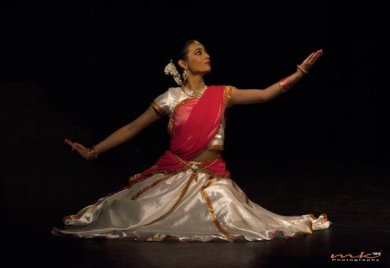
|   |

|   |
Samanvita glides through a historic dance performance in St. Louis - Anitha Nagendra July 16, 2016 St Louis, a Midwest City, which was the eye of the storm due to many incidents of racial discriminations, opened its eye to the beautiful sound of Kathak bells on July 9th. The almost three hour performance by young 14 year old Samanvita Kasthuri, a student of Parkway School district, created history as the first such Kathak dance debut with live music in the city. Born into a family of dancers, musicians, authors and yoga practitioners, dance and music have come easily to the talented young artist who gave her first dance recital at age four. Her dedication, constant practice and undiminishing interest in learning two forms of classical dance, classical music and classical instrument came to fruition as she danced brilliantly with grace, alacrity and ease.  Trained by her father and guru Prasanna Kasthuri for the last ten years, she began with a Rang Pooja, a salutation to the stage and to the deities of dance. In the opening dance number itself, Samanvita seemed completely in control of her graceful movements and exemplary rhythms. She continued with a couple of small dance numbers praising lord Shiva in the form of Nataraja in “Pashunam Pathi” and “Nataraja Kshitiraja.” The songs described the beauty of celestial dancing of Nataraja, the creator of dance. Samanvita, who seemed at ease with her invocation dance, was tranquil with the next lyrical “Te na vina,” a poem by Indian national poet Kuvempu, from Mysore. The superb dance choreography of Guru Prasanna unfurled as she delicately performed the message of oneness with god and nature. A pure technical number ‘Shuddh Nritya’ followed proving Samanvita’s prowess. Her grip over rhythm came to the forefront, as the dancer and the tabla virtuoso – Guru Naren Budhkar - exchanged complicated rhythmic patterns on the tabla and footwork. Samanvita recited the complicated rhythms effortlessly and accurately, apart from performing them elegantly. The audience revelled in technical pieces like aamad, uthaan, tora, tukdas, kavit and gath bhaav. The complex rhythmic patterns in three and four speeds in combinations of dadra (6 beats), teen taal (16 beats) and dhamaar (14 beats) showed the brilliance of this art form, the mastery of the young dancer and the taalim (practice) she put into her preparation.  Samanvita also proved that she had a flair for abhinaya in the next two items, a bhajan “Jhoolatha Radha sang Giridhari” and thumri “Chedo na Nand ke sunahu.” Both songs were based on the popular Hindu god Krishna. While the first song depicted the fun and frolic of the girls in Vrindavan playing in swings and with colors during the festival holi, the latter was a sober song where Radha requests Krishna to stop teasing and troubling her. Being trained in music by her mother Seema Kasthuri, helped her in effectively portraying the nuances. Samanvita performed Chaturang, literally meaning 4 parts - expression, rhythm, melody and literature. The four elements attributed to Shiva and Parvati beautifully choreographed by Guru Maya Rao (Prasanna’s guru) in the 1990s was performed well by Samanvita. Story telling was highlighted in the next dance drama ‘Parvathi Kalyan.’ The story of how Parvati was reborn and wins Shiva’s love was beautifully depicted. Huge stage settings added to the dramatic effect of the dance drama. The recital ended with a traditional taraana, an attractive combination of musical melodies and rhythmic phrases. The dance that began with a slow tempo gradually increased speed and ended with a sawaal-jawab (question-answer) and a grand tatkar-tihai. Samanvita was ably assisted by an erudite group of musicians. Senior tabla player Pandit Naren Budhkar excelled with his brilliant technique. Sitar player Indro Roy Chowdhary’s music interludes added color to the evening. Vocals by Divya Khandekar, Dyuthi Kharod and Guru Prasanna Kasthuri himself, harmonium by Vikas Falnikar and flute by Chethan Anant contributed to the success of the dance debut. The mega stage banners set an excellent backdrop, be it the sacred Kailasa Parvatha where Lord Shiva resides according to Hindu belief, or the beautiful Vrindavan gardens or the Indo-Persian architecture that depicts the amalgamation of two architectural styles. Added to this were the elegant lobby and stage decorations. |